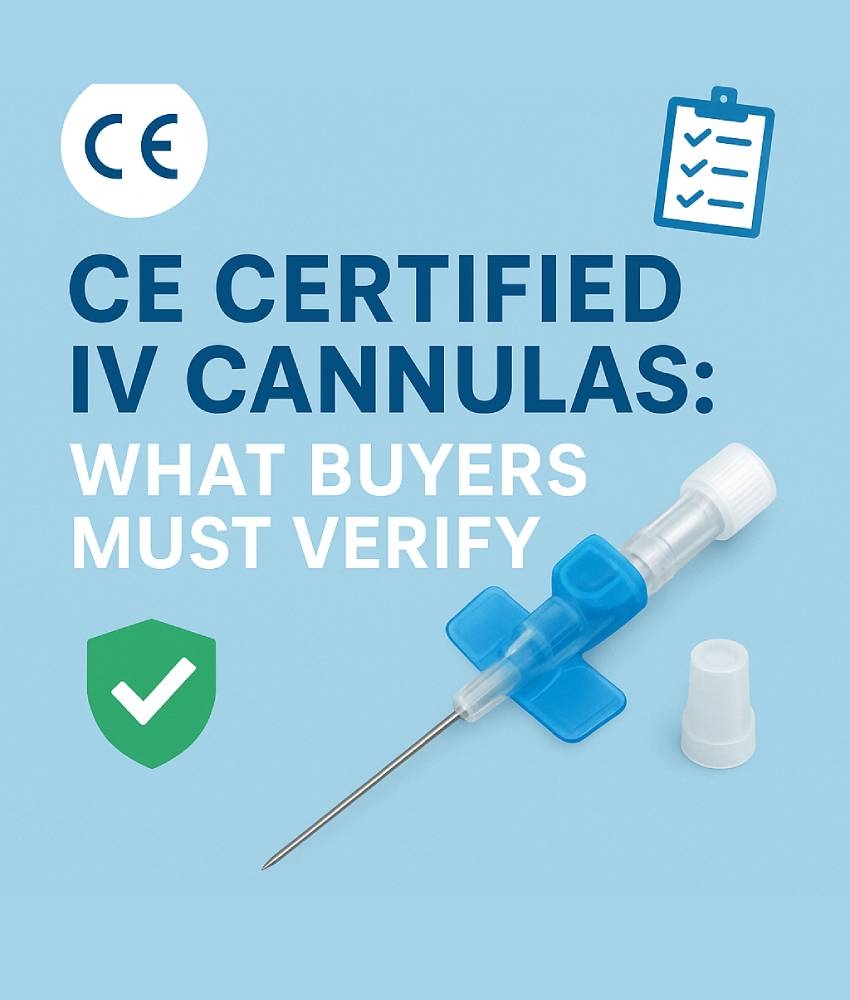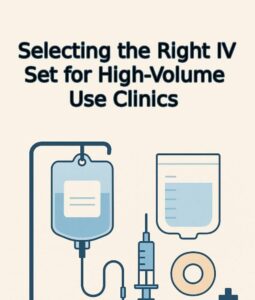When purchasing medical consumables, healthcare providers need clarity, not just convenience. The rise in demand for IV cannula CE approved products, the increasing preference for sterile IV catheter options, and the shift toward high-quality disposable IV cannula devices all point to one thing: buyers are prioritizing safety, compliance, and clinical performance. But not all CE-labeled products deliver the same value or security. Here’s what every procurement manager, hospital buyer, and clinician should verify before ordering CE-certified IV cannulas. Know more..
1. What Does “IV Cannula CE” Really Mean?
A product marked IV cannula CE indicates that it complies with the European Union’s Medical Device Regulation (MDR 2017/745). This certification is more than a regulatory checkbox—it’s a sign that the disposable IV cannula has passed rigorous testing, labeling, safety, and performance evaluations.
But here’s the catch: just because a product carries the IV cannula CE label doesn’t guarantee consistent quality across manufacturers. Buyers must look deeper.
2. The Anatomy of a CE-Certified Disposable IV Cannula
To ensure both performance and patient safety, a disposable IV cannula must meet several criteria:
- Cannula Hub: Should be ergonomically designed, often color-coded for gauge identification.
- Flashback Chamber: Confirms vein access by showing blood return.
- Needle: Made of medical-grade stainless steel, ultra-sharp for smooth insertion.
- Catheter Tube: A sterile IV catheter must use flexible, kink-resistant material like Teflon or polyurethane.
- Safety Valve or Port: For drug administration without needle reinsertion.
CE certification ensures each part complies with ISO 10555 standards, but buyers must still validate that components function properly and are documented in the technical file.
3. How to Spot a Legitimate IV Cannula CE Product
Look beyond the label. Here’s how to confirm that a IV cannula CE product is truly compliant:
a. Check the CE Marking Format
A legitimate CE mark includes a four-digit number indicating the notified body. For example:
CE 0123 – This shows that TÜV SÜD conducted conformity assessment.
If the disposable IV cannula has just “CE” with no number, it could be self-certified—a red flag for invasive Class IIa devices like IV cannulas.
b. Confirm Technical Documentation Exists
A compliant IV cannula CE product should come with a Declaration of Conformity (DoC), user manual, risk analysis, and performance testing data. Ask your supplier to share the DoC—it’s your right.
c. Verify the Manufacturer in the EUDAMED Database
All CE-certified sterile IV catheter products must be registered in the European Database on Medical Devices (EUDAMED). If you can’t find the product or manufacturer listed, think twice.
4. Why Sterility is Non-Negotiable
A sterile IV catheter isn’t just a preference—it’s a clinical necessity. Bacterial entry through an IV line is a leading cause of hospital-acquired infections (HAIs). That’s why sterility validation is a critical part of CE approval.
How Sterility is Ensured:
- Ethylene Oxide (EtO) Sterilization or Gamma Irradiation
- ISO 11135 or ISO 11137 compliance
- Validation cycles with biological indicators (BI) and dose audits
A disposable IV cannula claiming CE status must come with sterility documentation. Always check the expiry date, batch number, and sterilization method on the packaging.
5. What Clinical Buyers Should Always Verify
a. Gauge Range & Color Coding
Color standards for disposable IV cannula gauges (14G to 26G) are globally harmonized. Be sure the colors match clinical expectations. Mismatched color coding can lead to dosing errors or vein trauma.
b. Flow Rate Performance
Larger gauges (14G–18G) are used for trauma and rapid infusions. Confirm that flow rate tests match ISO standards for IV cannula CE devices.
c. Sharpness Testing & Insertion Force
A sterile IV catheter should pass penetration and friction testing. The lower the required insertion force, the less tissue trauma and pain for the patient.
d. Backflow Prevention & Flashback Clarity
Proper flashback allows nurses to verify placement quickly. Some disposable IV cannula designs now include backflow prevention valves or wings for better stabilization.
6. Red Flags: When CE Isn’t Enough
a. Suspiciously Low Pricing
Some sellers market cheap IV cannula CE products with incomplete documentation, expired CE certification, or counterfeit packaging. Always demand full documentation and a sample test batch before finalizing bulk orders.
b. No Distributor Transparency
If the local distributor can’t provide batch traceability or supply chain information for the sterile IV catheter, move on. A legitimate supplier knows their source.
c. Poor Packaging Integrity
Sterility is compromised if packaging is punctured, crinkled, or poorly sealed. Every disposable IV cannula must be individually packed in a tamper-evident, sealed pouch.
7. Global Standards for Disposable IV Cannula Devices
While CE certification is critical for EU markets, other global regions are aligning with similar protocols:
| Region | Regulation | CE Equivalency |
| USA (FDA) | 510(k) Clearance | CE not accepted; local submission required |
| Canada (Health Canada) | Medical Device License (MDL) | CE documentation supports review |
| Australia (TGA) | ARTG Listing | CE expedites approval |
| Middle East | SFDA / MOH Approval | CE often accepted or required |
| Africa | NHRA or NAFDAC | CE preferred for tenders |
| India | CDSCO Licensing | CE speeds up local clearance |
In most emerging markets, IV cannula CE approval is a fast track to product adoption.
8. Environmental Factors: The Green Shift in Disposable IV Cannula Production
As hospitals face pressure to reduce environmental footprints, manufacturers are innovating in materials and waste reduction. Buyers of disposable IV cannula products should assess:
- Use of medical-grade recyclable plastics
- Biodegradable or paper-based secondary packaging
- Reduced plastic in sterile pouches
- ISO 14001 environmental compliance at manufacturing sites
While sterility is still king, sustainability is quickly becoming the next frontier in sterile IV catheter production.
9. Training & Usage: What Nurses and Techs Need to Know
Even the best IV cannula CE product fails if improperly used. Hospitals and clinics should provide:
- Insertion Protocols aligned with WHO guidelines
- Videos demonstrating catheter insertion and removal
- In-service training with sample sterile IV catheter kits
- Competency testing for new staff
Additionally, feedback from frontline nurses often drives improvements in disposable IV cannula design, such as better grips or smoother bevels.
10. What Sets Premium CE IV Cannulas Apart?
Top-tier manufacturers invest heavily in research and material science. Here’s what sets a superior disposable IV cannula apart:
- Ultra-thin wall designs that boost flow without increasing gauge size
- Wings for easy taping and stabilization
- Safety needle guards to prevent needlestick injury
- Integrated injection ports for multi-use access
- Clearly labeled sterile IV catheter packaging with date, batch, and sterilization info
The top suppliers also maintain third-party audits, GMP-certified facilities, and full traceability—building long-term trust with hospitals and health ministries.
11. Procurement Checklist: Buying IV Cannula CE Products
Use this quick checklist to verify product quality and regulatory compliance before placing a bulk order:
✅ Is the CE mark valid and listed with a four-digit Notified Body?
✅ Can the supplier provide Declaration of Conformity and technical files?
✅ Is the product listed in EUDAMED?
✅ Does the sterile IV catheter package include sterility method, expiry date, and batch code?
✅ Have clinical users validated the device in real-world conditions?
✅ Are the packaging and individual units sealed and tamper-proof?
✅ Has the supplier maintained cold chain or proper storage conditions?
✅ Are gauges color-coded correctly and standardized?
✅ Are there post-market surveillance or complaint logs available?
✅ Is the manufacturer or distributor ISO 13485 certified?
If a product passes all these points, you can be confident you’re sourcing a reliable, safe, and regulation-compliant IV cannula CE device.
Final Thoughts
Choosing the right IV cannula CE, sterile IV catheter, or disposable IV cannula is more than a purchasing decision—it’s a clinical risk management step. Verifying CE compliance, sterility assurance, and manufacturing quality protects patients, staff, and your reputation.
With increased global scrutiny on device quality, hospitals and clinics must go beyond the surface and demand transparency, documentation, and performance data. When you align with CE-certified suppliers who prioritize safety and usability, you invest not just in products—but in better care.






